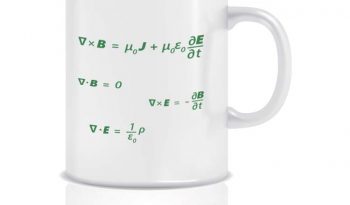In the post The physics behind grounding a conductor, I explained how grounding a conductor works. There I considered the problem of determining the electrostatic equilibrium state that two conducting spheres reach after being connected by a wire. One reader of that post asked me how that equilibrium state is reached from the initial state. I will answer that question here. But first, let’s state more precisely the problem.
Two conducting spheres of respective radii \(a\) and \(b\) are connected by a wire. Before connecting the spheres, the one with radius \(a\) is charged with a total charge of \(Q\), while the second one is uncharged. The spheres are far apart in such a way that the electric potential of any of them is negligible near the other one. If \(R\) is the total electric resistance of the wire, how the charge on both spheres changes with time after being connected to the wire?
Now let’s see how to answer the question.
Physical description of the problem
At any instant \(t\geq0\) the respective electric charges are \(Q_a(t)\) and \(Q_b(t)\), and the corresponding electric potentials of the spheres are
\begin{align}
\phi_a(t) &= k\frac{Q_a(t)}{a}\\
\phi_b(t) &= k\frac{Q_b(t)}{b}.
\end{align}
The voltage \(V(t)\) between the two spheres is the difference in their electric potentials:
\begin{equation}
\begin{split}
V(t) &= \phi_a(t)-\phi_b(t) \\
&= k\frac{Q_a(t)}{a}-k\frac{Q_b(t)}{b}.
\end{split}
\end{equation}
Conservation of the electric charge implies the relation
\begin{equation}
Q_a(t)+Q_b(t)=Q,
\end{equation}
so that the voltage can be expressed in terms of either \(Q_a\) only or \(Q_b\) only. Then, for example, we can write
\begin{equation}
\begin{split}
V(t) &= k\left[\frac{Q_a(t)}{a}-\frac{Q-Q_a(t)}{b}\right]\\
&= kQ_a(t)\left(\frac{1}{a}+\frac{1}{b}\right)-k\frac{Q}{b}
\end{split}
\end{equation}
The electric current \(I(t)\) that flows through the wire is related to the voltage through Ohm’s law:
\begin{equation}
V(t)=I(t)R.
\end{equation}
The electric current \(I(t)\geq0\) is the amount of electric charge that is transferred from one sphere to the other in the unit of time. So it is equal in magnitude to the rate of decrease of the charge \(dQ_a(t)/dt\) in the sphere of radius $a$. Notice that \(dQ_a/dt<0\). Indeed, the charge of the sphere of radius \(a\) is diminishing with time. Therefore, we have
\begin{equation}
I(t)=-\frac{dQ_a(t)}{dt}.
\end{equation}
Now we can use the equations (4) and (6) in equation (5) to obtain the differential equation that describes the dynamics of \(Q_a\):
\begin{equation}
\frac{dQ_a}{dt}+\frac{k}{R}\left(\frac{1}{a}+\frac{1}{b}\right)Q_a=\frac{kQ}{Rb}\ ;\\
Q_a(0)=Q.
\end{equation}
The initial charge on the sphere of radius \(a\) is assumed to be positive so that the current flows from this sphere to the other one as shown in the figure. Remember that the direction of the electric current is in the sense of motion of positive charges. Positive charges moving in one direction are equivalent to negative charges moving in the opposite direction.
Let’s see what this equation implies.
Dependence on time of the charge
The electrostatic equilibrium is reached when there is no change of the charge with time, i.e., when \(dQ_a/dt=0\). We see from equation (7) that the charge \(Q_a\) in the equilibrium state is
\begin{equation}
Q_a\to \frac{Q}{1+(b/a)}
\end{equation}
This result agrees with that obtained in the article The physics behind grounding a conductor (Compare with Eq.(4) in that article where \(a=R_1\) and \(b=R_2\)).
The solution of the equation (7) that satisfies the initial condition is
\begin{align}
Q_a(t)&=\left(\frac{1+(b/a)e^{-t/\tau}}{1+(b/a)}\right)Q\ ;\\
\tau&=\frac{R}{k}\left(\frac{1}{a}+\frac{1}{b}\right)^{-1}.
\end{align}
We can find \(Q_b(t)\) with help of equation (3), namely
\begin{equation}
Q_b(t)=\left(\frac{1-e^{-t/\tau}}{1+(a/b)}\right)Q\ ,
\end{equation}
and the current \(I(t)\) with help of equation (6):
\begin{equation}
I(t)=\frac{k}{R}\frac{Q}{a}e^{-t/\tau}.
\end{equation}
We see that the initial current \(I(0)=kQ/(aR)\) is consistent with equation (2) and Ohm’s law given in equation (5).


I am puzzled by the total PE before and after two positive spheres are connected. Let’s say they are identical spheres with +3 and +5 charge in any units. PE initially is k(15)/r. Then after equilibrium is reached by connecting them with the wire, the charges would be +4 and +4, yielding a greater PE=k16/r. This appears to violate conservation of energy!
Each electron that transfers moves to a lower potential energy state by moving to a higher potential sphere, so how can there be a net gain in PE, as well as a greater repulsive force between them? I am obviously missing something.